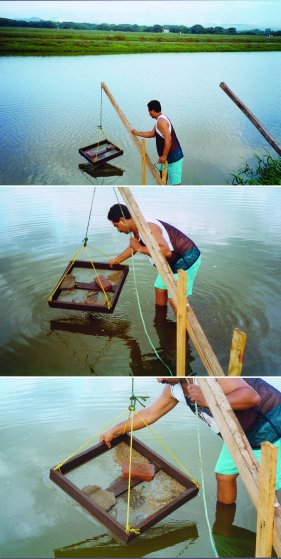Feeding
It is necessary to maintain an adequate phytoplankton density, to provide cover and control the growth of weeds in freshwater prawn ponds. This is done by encouraging the growth of phytoplankton. However, it is often unnecessary to fertilize, because this is rapidly achieved by the feeding regime. However, ponds built in a sandy-clay soil may require fertilization for this purpose. Where necessary, 25 kg/ha/month of triple superphosphate will keep the water green. Benthic fauna are very important features in the ecosystem of freshwater prawn ponds, forming part of the food chain for prawns. Fertilisation to encourage the development of benthic fauna is therefore recommended. Animal manures have been used for this purpose (e.g. 1000-3000 kg/ha of cattle manure).
The types of feed used in freshwater prawn farming vary widely and include individual animal or vegetable raw materials and feed mixtures prepared at the pond bank; both of these are generally referred to as ‘farm-made feeds'. In addition, commercial feeds designed for freshwater prawns are available. Freshwater prawns are omnivores and, so far as is known at present, their nutritional requirements are not very demanding. Some farmers utilize commercial feeds designed for marine shrimp in freshwater prawn nurseries or during the first few weeks of the grow-out phase when prawns are stocked as PL. Marine shrimp feeds have a much higher protein content than is needed for freshwater prawns, so cheaper commercial feeds that have either been specifically designed for freshwater prawns or for a species of fish (e.g. catfish) must be used in grow-out ponds stocked with nursery-reared juveniles, or substituted as soon as possible in those stocked with PL. The prawns are fed daily with formulated pellet diet (2-3 mm size) @ 10% of the biomass initially and then reduced to 3% of the biomass towards the end of the culture period.
Many different ingredients could be used in your farm-made feeds, either individually or combined into ‘compound feeds'. Commercial feeds for freshwater prawns tend to use ingredients, which are available in large quantities; many of them are global commodities, such as fish meal or soybean meal. In addition to ‘trash' fish, molluscs and prawn wastes form valuable animal protein sources. Pond water stands at risk of pollution if individual raw materials (not made into a mixed and bound compound feed), especially with wet materials (such as trash fish and beef liver) are used. Compounded feeds, especially when they are water-stable, cause less problems of this type. Compounded chicken and pig feeds, either unmodified, or re-extruded through a mincer with trash fish or prawn meal, have been used in freshwater prawn farming.
Feed formula for Freshwater prawn
| Ingredients | Feed 1 (%) | Feed 2 (%) |
|---|---|---|
| Fishmeal | 20 | - |
| Shrimp Head meal | - | 30 |
| Soya meal | 9 | 5 |
| Rice bran | 45 | 35 |
| Coconut oil cake | 20 | 20 |
| Tapioca starch | 5 | 9 |
| Mineral premix | 1 | 1 |
| Total | 100 | 100 |
There can be no exact general recommendation for daily feeding rates, because these depend on the size and number of prawns (and, in a polyculture system, fish) in the pond, the water quality, and the nature of the feed. The feed should be broadcasted in the pond as mentioned above. Spread the feed around the periphery of the pond in the shallows, which are good feeding zones. Check trays 3-4 nos may be kept in different corners of the pond to check the consumption of food.

